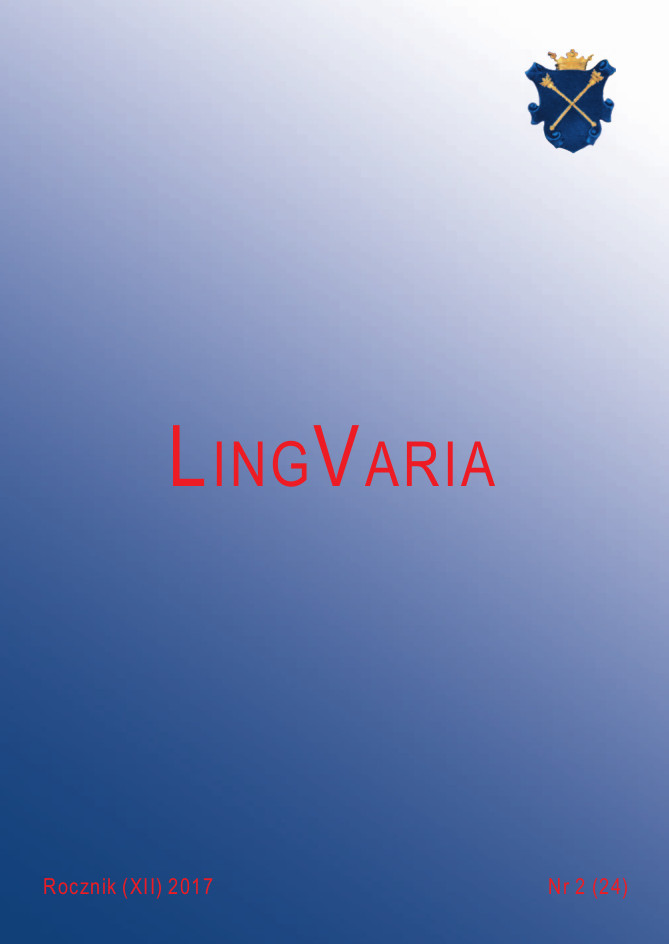Łacińskie lōrum w świetle etymologii
DOI:
https://doi.org/10.12797/LV.12.2017.24.12Słowa kluczowe:
etymologia, języki indoeuropejskie, leksyka indoeuropejska, łacina, słowotwórstwoAbstrakt
Latin lōrum in the Light of Etymology
The traditional etymology of Lat. lōrum n. ‘strap, girdle, rein’, according to which it is related to Arm. lar ‘strick, rope, band’ and Greek (Homeric) εὔληρα, Doric αὔληρα n. pl. ‘reins’, should be rejected for phonological and morphological reasons. The present author suggests a new explanation of the Latin term in question. It derives from the Italic archetype *lōsom n. ‘strap, belt, girdle’. Close equivalents are attested in Indo-Iranian, cf. Old Indic rā́snā- f. ‘girdle’ (< IE. *lōsnā); Khotan Saka rrānä ‘belt’, Ossetic ron ‘belt, girdle’ (< Iranian *rāhnā- < IE. *lōsnā), Sogdian r’n’(kh) ‘belt’ (< Iran. *rāhnā-ka-); Wakhi ran-dáq, ran-dak ‘leather strap’ (< Iran. *rāhna-taka-). The Indo-European root *lōs- (< PIE. *leh₃s-) is also attested in Ancient Greek, cf. Gk. λῶμα n. ‘hem, fringe, border of cloths’ (< IE. *lṓs-mn̥ n.), Aeolic λῶστοι pl. ‘stitched’, ἄλωστοι pl. ‘unstitched’, εὔλωστοι pl. ‘well-vowen’ (< IE. *lōs-tó-). The author explains Latin lōrus (m.) as an innovative form created on the basis of the irregular plural lōrī, originally nom.-acc. du. n. *lōso-ī ‘two straps, two reins’ (< PIE. *leh₃so-ih₁). The loss of the dual number in the early pre-literary phase of the development of the Latin language caused the reinterpretation of preserved dual forms. It is emphasized that Lat. frēnum n. ‘bit, cub, bridle’ attests not only the regular plural frēna ‘reins’, but also the irregular frēnī (orig. nom.-acc. du. n.).
Pobrania
Bibliografia
Abajew W.I., 1973 [= V.I. Abaev], Istoriko-ètimologičeskij slovarʹ osetinskogoâzyka, t. 2, Leningrad.
Abramowiczówna Z. (red.), 1960–1962, Słownik grecko-polski, t. 2, 1960, t. 3, 1962, Warszawa.
Bailey H.W., 1979, Dictionary of Khotan Saka, Cambridge.
Beekes R.S.P., 1969, The Development of the Proto-Indo-European Laryngeals in Greek, The Hague – Paris.
Beekes R.S.P., 1988, Laryngeal Developments: a Survey, [w:] A. Bammesberger (red.), Die Laryngaltheorie, Heidelberg, s. 59–105.
Beekes R.S.P., 2010, Etymological Dictionary of Greek, Leiden – Boston.
Beekes R.S.P., 20112, Comparative Indo-European Linguistics. An Introduction, revised and corrected by M. de Vaan, Amsterdam – Philadelphia.
Boisacq É., 1916, Dictionnaire étymologique de la langue grecque. Étudiée dans ses rapports avec les autres langues indo-européennes, Heidelberg – Paris.
Buck C.D., 1905, Elementarbuch der oskisch-umbrischen Dialekte, Heidelberg.
Chantraine P., 1970, Dictionnaire étymologique de la langue grecque. Histoire des mots, t. 2, Paris.
Cheung J., 2007, Etymological Dictionary of the Iranian Verb, Leiden – Boston.
Clackson J., Horrocks G., 2007, The Blackwell History of the Latin Language, London.
da Cunha A.G., 19982, Dicionário etimológico Nova Fronteira da língua portuguesa, Rio de Janeiro.
Curtius G., 18795, Grundzüge der griechische Etymologie, Leipzig.
Derksen R., 2015, Etymological Dictionary of the Baltic Inherited Lexicon, Leiden – Boston.
Ernout A., Meillet A., 20014, Dictionnaire étymologique de la langue latine. Histoire des mots, Paris.
Frisk H., 1960, Griechisches etymologisches Wörterbuch, t. 1, Heidelberg.
Fritz M., 2011, Der Dual im Indogermanischen. Genealogischer und typologischer Vergleich einer grammatischen Kategorie im Wandel, Heidelberg.
Hofmann J.B., 1950, Etymologisches Wörterbuch des Griechischen, München.
Jurewicz O., 19992, Gramatyka historyczna języka greckiego, Warszawa.
Korpanty J. (red.), 2003, Słownik łacińsko-polski, t. 2, Warszawa 2003.
Latte K., 1953–1966, Hesychii Alexandrini Lexicon, t. 1 (Α–Δ), 1953, t. 2 (Ε–Ο), 1966, Hauniae.
Leumann M., 1977, Lateinische Laut- und Formenlehre, München.
Lidén E., 1906, Armenische Studien, Göteborg.
Matasović R., 2004, Gender in Indo-European, Heidelberg.
Meier-Brügger M., 2003, Indo-European Linguistics, Berlin – New York.
Meiser G., 20062, Historische Laut- und Formenlehre der lateinische Sprache, Darmstadt.
Meyer-Lübke W., 19353, Romanisches etymologisches Wörterbuch, Heidelberg.
Monier-Williams M., 1999, A Sanskrit-English Dictionary, Delhi.
Muller F., 1926, Altitalisches Wörterbuch, Göttingen.
Otrębski J., Safarewicz J., 1937, Gramatyka historyczna języka łacińskiego, Warszawa.
Peters M., 1980, Untersuchungen zur Vertretung der indogermanischen Laryngale im Griechischen, Wien.
Plezia M. (red.), 1962–1998, Słownik łacińsko-polski, t. 2, 1962, t. 3, 19982, Warszawa.
Pokorny J., 1959, Indogermanisches etymologisches Wörterbuch, Bern – München.
Prellwitz W., 1892, Etymologisches Wörterbuch der griechischen Sprache, Göttingen.
Rix H. (red.), 20012, Lexikon der indogermanischen Verben, Wiesbaden.
Schrijver P., 1991, The Reflexes of the Proto-Indo-European Laryngeals in Latin, Amsterdam – Atlanta.
Schwyzer E., 1939, Griechische Grammatik, München.
Sihler A.L., 1995, New Comparative Grammar of Greek and Latin, New York – Oxford.
Smoczyński W., 2007, Słownik etymologiczny języka litewskiego, Wilno.
Solmsen F., 1901, Untersuchungen zur griechischen Laut- und Verslehre, Strassburg.
Souter A., Wyllie J.M. (red.), 1968, Oxford Latin Dictionary, Oxford.
Steblin-Kamenskij I.M., 1999, Ètimologičeskij slovarʹ vahanskogo âzyka / Etymological Dictionary of the Wakhi Language, Sankt-Peterburg / Sankt Petersburg.
Tagliavini C., 1962, Fonetica e morfologia storica del latino, Bologna.
Trautmann R., 1923, Baltisch-Slavisches Wörterbuch, Göttingen.
de Vaan M., 2008, Etymological Dictionary of Latin and the Other Italic Languages, Leiden – Boston.
Vaniček A., 18812, Etymologisches Wörterbuch der lateinischen Sprache, Leipzig.
Walde A., 1910, Lateinisches etymologisches Wörterbuch, Heidelberg.
Walde A., Hoffmann J., 1938, Lateinisches etymologisches Wörterbuch, t. 1, Heidelberg.
Walde A., Pokorny J., 1930, Vergleichendes Wörterbuch der indogermanischen Sprachen, t. 1, Berlin – Leipzig.
Weiss M., 2009, Outline of the Historical and Comparative Grammar of Latin, Ann Arbor – New York.
Witczak K.T., 2015, Konsekwencje zaniku liczby podwójnej w języku łacińskim. Głos w sprawie dualnej genezy piątej deklinacji łacińskiej, „Roczniki Humanistyczne” LIII, z. 6, s. 101–120.
Pobrania
Opublikowane
Numer
Dział
Licencja
Prawa autorskie (c) 2017 Krzysztof Tomasz Witczak

Utwór dostępny jest na licencji Creative Commons Uznanie autorstwa – Użycie niekomercyjne – Bez utworów zależnych 4.0 Międzynarodowe.






